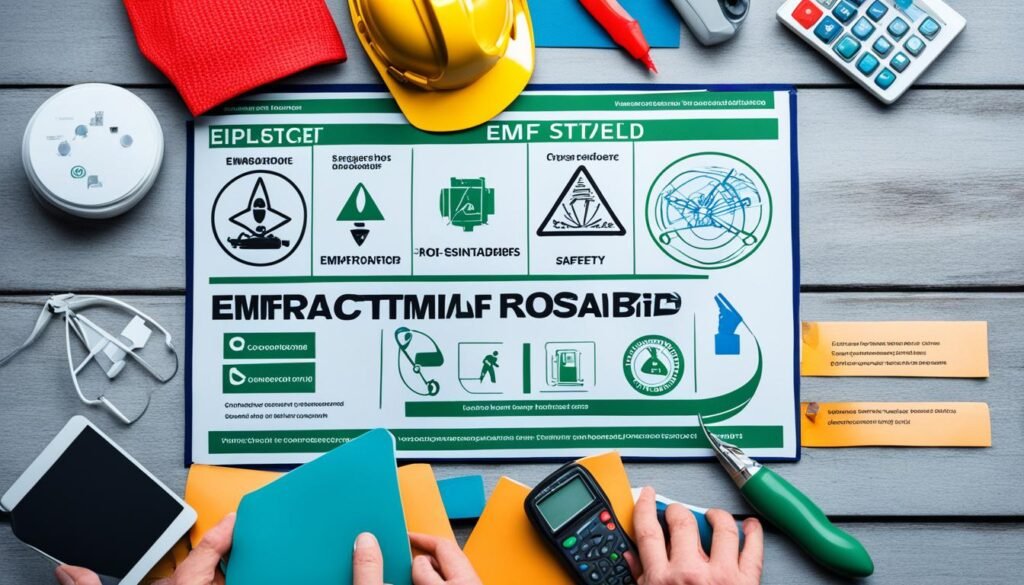Disclosure: This Post Contains Affiliate Links; We earn a commission on purchases.
Welcome to our in-depth exploration of stakeholder perspectives on international EMF guidelines. In today’s interconnected world, electromagnetic fields (EMFs) have become a prevalent part of our daily lives, emanating from various sources such as power lines, electrical devices, and wireless communication technologies. As concerns about the potential health effects of EMF exposure continue to grow, it is crucial to examine the viewpoints of stakeholders to ensure effective regulations and standards.
Stakeholders, including government bodies, industry representatives, researchers, and the public, have unique insights and concerns that should be taken into account when developing EMF guidelines. These stakeholders play a significant role in shaping and influencing regulations, EMF exposure limits, and policies related to public safety and well-being.
Key Takeaways:
- Stakeholder perspectives are critical in formulating international EMF guidelines.
- Various stakeholders, including the public, government, and industries, need to be involved in the decision-making process.
- EMF exposure limits and regulations should consider both scientific research and public concerns regarding potential health effects.
- Collaboration and dialogue between stakeholders can bridge the gap between policy development and public understanding.
- Addressing stakeholder concerns ensures that EMF guidelines are comprehensive, responsive, and better accepted by all parties involved.
The Importance of Stakeholder Engagement in EMF Policy
Stakeholder engagement plays a vital role in shaping effective EMF policy guidelines that address the concerns and perspectives of all relevant parties. By actively involving stakeholders, including the public, in the decision-making process, policies can be more comprehensive, responsive to public concerns, and have a higher chance of acceptance and successful implementation.
Public concerns regarding EMF exposure and its potential health effects must not be overlooked. It is crucial to consider the diverse voices and experiences of stakeholders, as this allows for a more holistic understanding of the issue. By engaging stakeholders in the policy development process, a wide range of perspectives can be incorporated, ensuring that the resulting guidelines address the needs and values of the community.
“Stakeholder engagement is an essential component in policy development. It gives the public a platform to voice their concerns and contribute to shaping guidelines that align with their interests and values.”
One successful example of effective stakeholder engagement in EMF policy is the Stakeholder Advisory Group on Extremely Low Frequency Electric and Magnetic Fields (EMFs), or SAGE, in the UK. SAGE brings together various stakeholders, including campaign groups, industries, and the government, to consider precautionary measures related to EMFs. This collaborative approach fosters better communication, understanding, and trust among stakeholders, bridging the gap between scientific knowledge, public perceptions, and policy development.
Through stakeholder engagement, the precautionary approach can be effectively applied in EMF policy development. By actively involving stakeholders, policies can reflect a cautious stance that prioritizes public health and safety. The concerns raised by the public regarding EMFs can be properly addressed, leading to guidelines that are better suited to the needs and expectations of the community.
Engaging stakeholders in EMF policy development is essential for promoting transparency, inclusivity, and legitimacy. It ensures that decisions are not made in isolation, but instead take into account the diverse perspectives and concerns of those who are directly affected by EMF exposure. By incorporating a variety of viewpoints, EMF policy guidelines can better serve the public interest and foster a sense of trust and credibility among stakeholders.
Stakeholder engagement in EMF policy is a collaborative process that draws on the collective wisdom and understanding of various stakeholders. By involving the public and other relevant parties, guidelines can be developed that strike a balance between scientific evidence and public concerns. This approach not only strengthens the legitimacy of the guidelines but also ensures that EMF policy remains responsive and adaptive to emerging concerns and new scientific findings.
The importance of stakeholder engagement in EMF policy cannot be overstated. By actively involving stakeholders, especially the public, in the decision-making process, guidelines can better address public concerns, reflect a precautionary approach, and foster a sense of trust and legitimacy. The success of the SAGE process in the UK highlights the positive impact of stakeholder engagement in shaping EMF policy that takes into account the diverse perspectives and needs of all stakeholders.
Existing Guidelines vs. the Need for Precautionary Measures
The current guidelines for EMF exposure, set by the government based on the recommendations of the Health Protection Agency in the UK, primarily focus on well-understood effects at higher exposure levels. However, recent scientific evidence suggests potential health effects at lower exposure levels, including a possible association between childhood leukemia and exposure levels of 0.4 µT.
This poses a challenge as these lower exposure levels can be found in some homes, leading to concerns from the public. While the existing guidelines provide protection against known risks, there is a need to consider precautionary measures that address the emerging evidence on potential health effects at lower exposure levels.
The SAGE process, which involves various stakeholders including campaign groups, industries, and the government, was initiated to address these concerns and explore the implications of a precautionary approach for EMF guidelines.
“It is crucial to balance the current knowledge with an understanding of the potential risks associated with lower exposure levels. Applying precautionary measures can help protect public health and provide reassurance.”
EMF Health Effects and Childhood Leukemia
The association between childhood leukemia and exposure to electromagnetic fields (EMF) has been a subject of scientific investigation. A comprehensive study conducted by the Childhood Cancer Research Group in the UK found a small but consistent association between higher levels of magnetic fields and an increased risk of childhood leukemia.
While the mechanisms underlying this association are still being researched, it highlights the importance of considering lower exposure levels in EMF guidelines to protect vulnerable populations, especially children.
Emerging Research on Lower Exposure Levels
New research suggests potential health effects at lower exposure levels, which fall within the range of typical residential environments. These emerging findings challenge the notion that existing guidelines adequately address all potential risks related to EMF exposure.
Studies utilizing advanced measurement techniques have demonstrated that exposure levels below the current guidelines may still have biological effects. For instance, a recent study conducted by Dr. Martin Röösli, Professor of Environmental Epidemiology at the Swiss Tropical and Public Health Institute, found a connection between high nighttime magnetic field exposure and a higher risk of childhood leukemia.
These findings support the need for precautionary measures to minimize potential health risks, especially for individuals who may have prolonged exposure to electromagnetic fields.
| Existing Guidelines | Precautionary Measures |
|---|---|
| – Focus on well-understood effects at higher exposure levels | – Consider potential health effects at lower exposure levels |
| – Limited protection for vulnerable populations | – Address concerns for children and other vulnerable groups |
| – Guidelines set based on current scientific consensus | – Stay updated with emerging research and revise guidelines accordingly |
It is crucial to strike a balance between the current knowledge and the potential risks associated with lower exposure levels. Applying precautionary measures can help protect public health and provide reassurance. Ongoing research and collaboration among stakeholders, as exemplified by the SAGE process, are essential in refining EMF guidelines to ensure the well-being and safety of the population.

Practical Recommendations and Measures for EMF Safety
During the SAGE process, several practical recommendations and measures were put forth to ensure EMF safety, with a specific focus on distribution systems and substations. Implementation of these recommendations is essential to minimize EMF exposure and potential health risks. Some of the key recommendations are:
- Balancing loads on circuits to reduce excessive exposure.
- Repairing broken neutrals to prevent higher EMF levels.
- Disconnecting redundant cables to minimize unnecessary EMF emissions.
- Using plastic pipes for gas and water to prevent the interference of EMF.
- Avoiding the proximity of plant rooms to occupied areas, ensuring reduced exposure.
- Designing compact substations to minimize the extent of EMF emissions.
These recommendations, when implemented, contribute significantly to the overall safety and well-being of individuals working in distribution systems and substations. Creating awareness about EMF issues is crucial to ensure compliance with the recommended safety measures.
Training programs and information dissemination initiatives should be conducted regularly within the electricity industry and among the general public. This ensures that both professionals and the public are aware of the potential risks associated with EMF exposure and are equipped with the knowledge to implement safety standards effectively.
By following these practical recommendations and increasing awareness about EMF safety, we can ensure that distribution systems and substations adhere to the necessary safety standards and protect the health and well-being of individuals in these environments.

Sample EMF Safety Standards for Substations (Table)
| Standard | Requirement |
|---|---|
| Minimum Clearance Distance | Substations must maintain a specific distance from public areas and residential buildings to limit EMF exposure. |
| EMF Monitoring | Regular monitoring of EMF levels within substations to ensure compliance with safety thresholds. |
| Protective Clothing | Personnel working in substations should wear appropriate protective clothing to minimize EMF exposure. |
| Signage and Warning | Substations should have clear signage to inform individuals about potential EMF hazards and safety precautions. |
| Training and Education | Regular training programs should be provided to personnel, emphasizing the importance of EMF safety and proper handling procedures. |
Conclusion
In conclusion, the perspectives of stakeholders, including the public, play a crucial role in shaping international EMF guidelines. The engagement of stakeholders is vital for the development of comprehensive and effective policies that address the concerns and health effects associated with EMF exposure. The success of the Stakeholder Advisory Group on Extremely Low Frequency Electric and Magnetic Fields (SAGE) in the UK serves as an example of how stakeholder engagement and collaboration can contribute to policy development.
Moving forward, it is essential to continue considering the viewpoints of stakeholders and incorporating their feedback into the ongoing review and refinement of EMF guidelines. This ensures that the concerns and interests of the public are taken into account, and that policies are responsive to the evolving scientific understanding of EMF health effects.
By prioritizing stakeholder perspectives in the policy development process, we can ensure that EMF guidelines are evidence-based, transparent, and promote public health and safety. It is through this collaborative approach that we can address public concerns, strengthen EMF regulations, and foster a better understanding of EMF exposure in the context of rapidly advancing technologies.
Source Links
- https://www.powerwatch.org.uk/elf/sage.asp
- https://www.ncbi.nlm.nih.gov/pmc/articles/PMC10820716/
- https://www.frontiersin.org/journals/public-health/articles/10.3389/fpubh.2023.1339513/full

Subscribe to Our Newsletter










